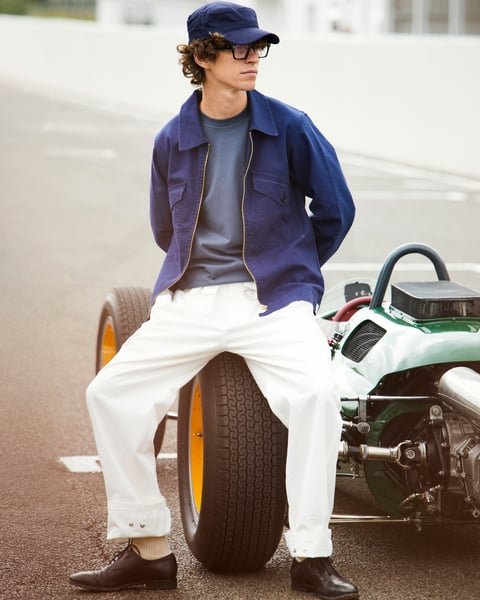Meeting the man behind the reborn Pantera
Goodwood and coachbuilt cars go together like strawberries and cream, so talk of a new company that can re-body a vehicle to its owner’s precise requirements deserves some attention.

The firm in question is Ares Design, and judging by its new 18,000-square metre facility it means business. Based on the northern edge of Modena in Italy, Ares is the brainchild of Dany Bahar, a 46-year-old entrepreneur whose career to date has included impressive stints at Red Bull and Ferrari, as well as a more contentious spell as CEO of Group Lotus. It was in this final position that Bahar led a team to launch five new concept cars at the 2010 Paris Motor Show, as well as instigate the return of the Lotus name to Formula One. Things might not ultimately have panned out as Bahar had planned (he departed Lotus in 2012 before the first of the new cars, the Esprit, could be launched), but in combination with old colleagues and financial backers, it wasn’t long before the seeds for Ares had been sewn.
As with so many start-ups, the business has changed course from its original plan of personalising cars with new leather trim, big wheels and enhanced power outputs, and now centres very much on more bespoke projects. Or, as Bahar puts it: “It is one-off coachbuilding at a much more affordable level than has ever been possible before”.
There are three distinct tiers to this, the first two of which involve creating new bodywork for current production cars, while the third centres on updating classic cars with modern underpinnings. To put the ‘affordable’ element of it into perspective we are still talking the best part of £700,000 for the newer option, while classics tend to come in at around £360,000.
There were numerous examples of all types of project present when Goodwood visited Ares Design’s pristine new facility in early 2018. First things first, if your idea of coachbuilding involves a small team toiling away in a dingy garage, then the ultra-modern, open plan setup run by Ares with its 100 or so staff working in meticulously clean environments is going to come as something of a shock. “I really want to show that coachbuilding can be very modern and very sexy,” says Bahar. “It’s not something you do with three men in a shed in Coventry. This facility makes people feel comfortable we have the capabilities.”
Of course, that’s all for nothing if the quality of the workmanship doesn’t stand up. To this end, Ares uses in-house expertise for some jobs and outsources others to specialists. “We don’t claim we are car manufacturers or the best engineers,” explains Bahar. “We are the best project managers combining car-making expertise with the personalised touch a buyer has in mind, always respecting homologation and safety.”
The result is cars such as the Mercedes G-Class based X-Raid, a gargantuan carbon-fibre glad off-roader of which Ares has so far built 11 examples. On the classic side meanwhile are cars such as a 1964 Corvette Stingray that has cleverly been wrapped over the underpinnings of a modern LS7, and a Porsche 964 Targa that is in the process of taking on the running gear of a contemporary 911.
Perhaps most interesting of all, however, is the idea of reinterpreting the shape and layout of a classic car in a thoroughly modern format. The first example of this is Project Panther, an updated take on the De Tomaso Pantera that was commissioned by an owner of an immaculate example of the 1970s original. The result is a wedge-shaped wonder based on the chassis and engine of a Lamborghini Huracan, but with new bodywork to give a convincing take on what a Pantera of 2018 might be like. It looks fantastic.
Along the same lines is ‘Project Pony’, which Bahar says is about to enter the build phase following a commission from a Ferrari collector who wanted a modern take on his 400. As with the Panther, Ares has cleverly carried styling cues from the old car into a design that while still retro is also clearly of the modern age.

By and large, these new designs sit on the same fixing points as the body of the donor car (a GTC4 Lusso in the case of Project Pony), which Bahar says means Ares is able to comply with TUV regulations without needing to undergo complete crash tests – although that’s not always the case. With the Panther, for example, Ares has moved the Huracan’s A-pillar and will thus “not be able to get around the crash test,” says Bahar. Doing so is a time-consuming and expensive process, but important for the company’s success.
Ultimately it is such attention to detail that should give Ares the credibility required to succeed in this exclusive sector of the market, along with the company’s belief it can be less constrained, faster and cheaper than if a customer goes direct to a manufacturer and asks for a similar kind of project. Whether the result is something outlandish such as the X-Raid, or a relatively restrained aesthetic change such as one of the Bentley Mulsanne Coupes that engineers are in the process of finishing depends entirely on the tastes of whoever commissions it.
On that subject Bahar is of the view that “taste is not debatable – you go with the customer,” assuming, of course, the work can be done within technical limitations and safety constraints. With the results to date already looking so impressive, it is not implausible that we could see one of Ares Design’s projects on the Goodwood lawn in years to come.
Ares
Panther
Pantera









